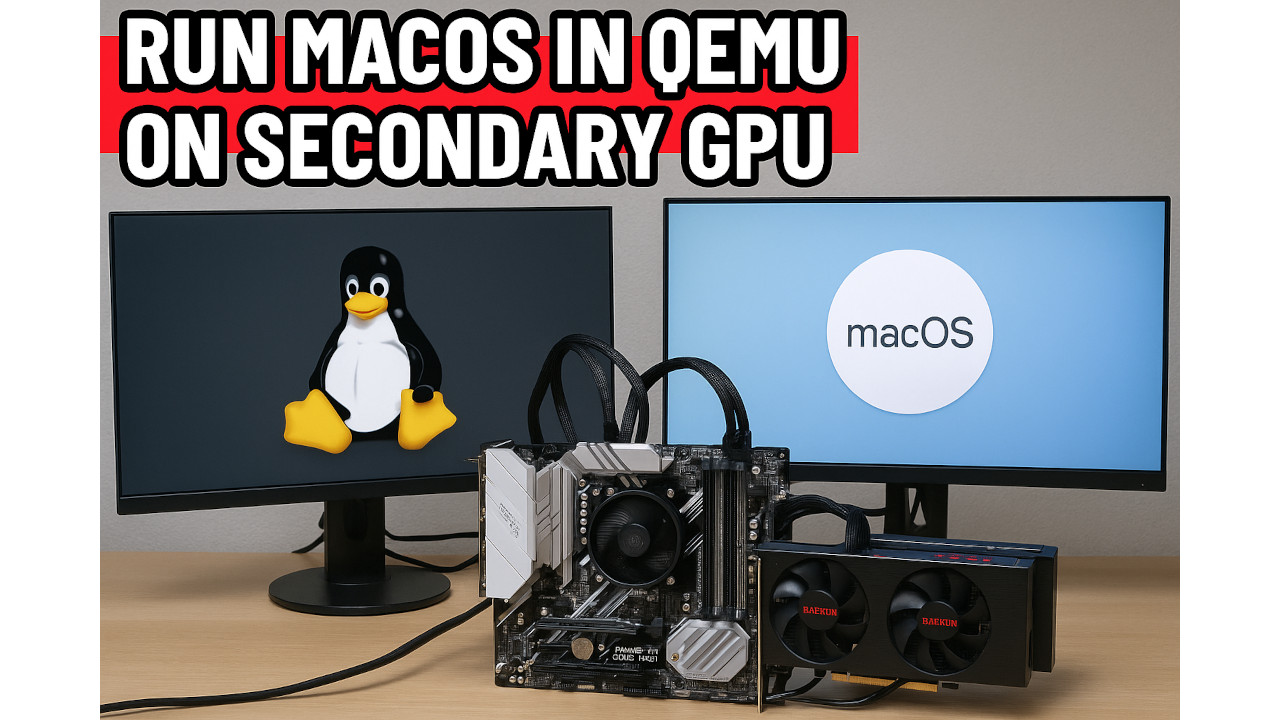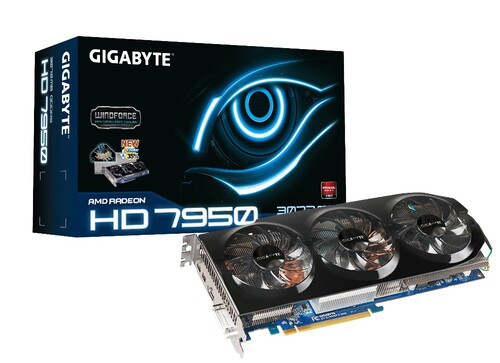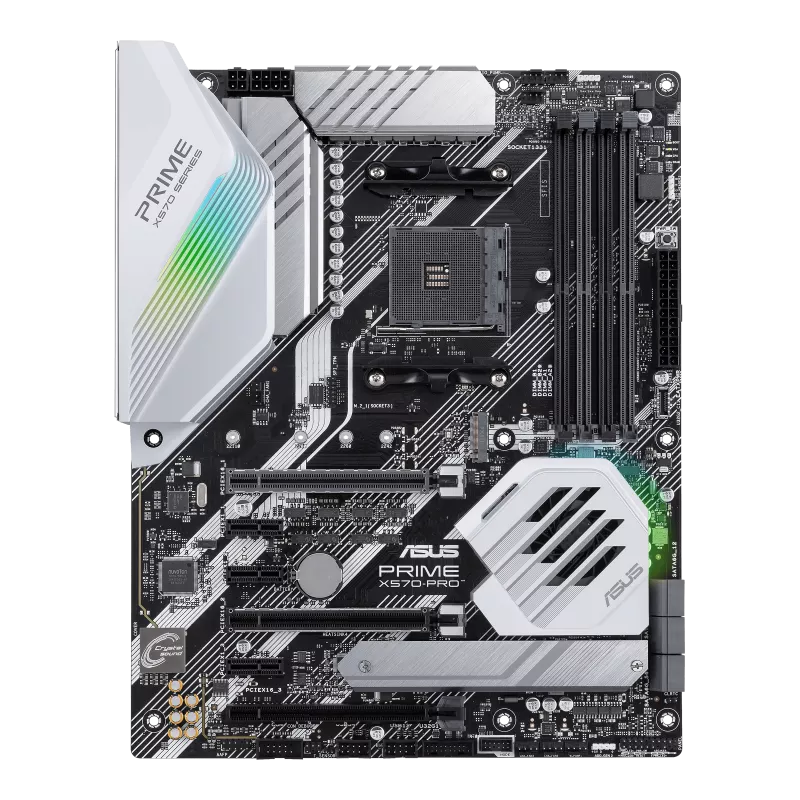Run MacOS in Linux with Qemu on secondary GPU
- david
- Site Admin
- Posts: 417
- Joined: Sat May 21, 2016 7:50 pm
Run MacOS in Linux with Qemu on secondary GPU
How to run MacOS in Linux on secondary GPU using Qemu as emulator and native GPU passed to emulated VM:

Join our telegram group if you wana chat or have specific questions:
https://t.me/+h2K5CX5jEZA0MWJk
PC test hardware is:
CPU - Ryzen 5950 16 core 32T
Ram - 128GB Ram Kingston 4x32GB 3400Mhz CL16
MB - Asus PRIME X570-PRO
PSU - 850W Seasonic
Radeon 560 connected to native linux OS and Radeon 7950 gpu`s passed to the MacOS.

Asus PRIME X570-PRO support 2 x PCIe 4.0 x16 (x16 or dual x8) runing native Devuan (Debian with no SystemD) linux!
You can install qemu on almost any linux distro here in this example i use Devuan linux and qemu 7.2.

Here how lspci -nnk command looks on my PC make sure you put your secondary GPU into vfio mode:
Qemu conig:
Radeon 7950 GPU is 2012 GPU can work in MACOS monterey very good.
To download ready to use Qemu virtual hdd file "mac_hdd_ng.img" enter our telegram group:
https://t.me/+h2K5CX5jEZA0MWJk
Video demonstration of MacOS Monterey running in Qemu.
youtu.be/QVDMa7MuiGg

Join our telegram group if you wana chat or have specific questions:
https://t.me/+h2K5CX5jEZA0MWJk
PC test hardware is:
CPU - Ryzen 5950 16 core 32T
Ram - 128GB Ram Kingston 4x32GB 3400Mhz CL16
MB - Asus PRIME X570-PRO
PSU - 850W Seasonic
Radeon 560 connected to native linux OS and Radeon 7950 gpu`s passed to the MacOS.

Asus PRIME X570-PRO support 2 x PCIe 4.0 x16 (x16 or dual x8) runing native Devuan (Debian with no SystemD) linux!
You can install qemu on almost any linux distro here in this example i use Devuan linux and qemu 7.2.
Here how lspci -nnk command looks on my PC make sure you put your secondary GPU into vfio mode:
Code: Select all
09:00.0 VGA compatible controller [0300]: Advanced Micro Devices, Inc. [AMD/ATI] Tahiti PRO [Radeon HD 7950/8950 OEM / R9 280] [1002:679a]
Subsystem: Gigabyte Technology Co., Ltd Tahiti PRO [Radeon HD 7950/8950 OEM / R9 280] [1458:254c]
Kernel driver in use: vfio-pci
Kernel modules: radeon, amdgpu
09:00.1 Audio device [0403]: Advanced Micro Devices, Inc. [AMD/ATI] Tahiti HDMI Audio [Radeon HD 7870 XT / 7950/7970] [1002:aaa0]
Subsystem: Gigabyte Technology Co., Ltd Tahiti HDMI Audio [Radeon HD 7870 XT / 7950/7970] [1458:aaa0]
Kernel driver in use: vfio-pci
Kernel modules: snd_hda_intel
0a:00.0 VGA compatible controller [0300]: Advanced Micro Devices, Inc. [AMD/ATI] Baffin [Radeon RX 550 640SP / RX 560/560X] [1002:67ff] (rev cf)
Subsystem: Micro-Star International Co., Ltd. [MSI] Baffin [Radeon RX 550 640SP / RX 560/560X] [1462:8a91]
Kernel driver in use: amdgpu
Kernel modules: amdgpu
0a:00.1 Audio device [0403]: Advanced Micro Devices, Inc. [AMD/ATI] Baffin HDMI/DP Audio [Radeon RX 550 640SP / RX 560/560X] [1002:aae0]
Subsystem: Micro-Star International Co., Ltd. [MSI] Baffin HDMI/DP Audio [Radeon RX 550 640SP / RX 560/560X] [1462:aae0]
Kernel driver in use: snd_hda_intel
Kernel modules: snd_hda_intel
Code: Select all
qemu-system-x86_64 \
-enable-kvm \
-machine q35,accel=kvm \
-cpu Haswell,kvm=on,vendor=GenuineIntel,+kvm_pv_unhalt,+kvm_pv_eoi,+hypervisor,+invtsc,+ssse3,+sse4.2,+popcnt,+avx,+avx2,+aes,+fma,+bmi1,+bmi2,+xsave,+xsaveopt,check \
-smp sockets=1,cores=4 \
-m 16380 \
-smbios type=2 \
-drive if=pflash,format=raw,readonly=on,file=OVMF_CODE.fd \
-drive if=pflash,format=raw,file=OVMF_VARS-1920x1080.fd \
-device isa-applesmc,osk="ourhardworkbythesewordsguardedpleasedontsteal(c)AppleComputerInc" \
-global ICH9-LPC.acpi-pci-hotplug-with-bridge-support=off \
-device ich9-ahci,id=sata \
-drive id=MacHDD,if=none,file=mac_hdd.img,format=qcow2 \
-device ide-hd,bus=sata.1,drive=MacHDD \
-vga none \
-netdev user,id=net0,hostfwd=tcp::2222-:22 -device virtio-net-pci,netdev=net0,id=net0,mac=52:54:00:c9:18:27 \
-device nec-usb-xhci,id=xhci \
-device usb-host,vendorid=0x248a,productid=0x00da,bus=xhci.0,port=1 \
-device usb-host,vendorid=0x046d,productid=0xc52f,bus=xhci.0,port=2 \
-device usb-host,vendorid=0x04ca,productid=0x007d,bus=xhci.0,port=3 \
-device usb-host,vendorid=0x1058,productid=0x0730,bus=xhci.0,port=4 \
-device nec-usb-xhci,id=xhci1 \
-device usb-host,vendorid=0x0b05,productid=0x17cb,bus=xhci1.0,port=1 \
-device pcie-root-port,id=pcie1,slot=1,chassis=1 \
-device vfio-pci,host=0c:00.0,bus=pcie1,addr=0x0,multifunction=on,x-no-kvm-intx=on,x-vga=on \
-device vfio-pci,host=0c:00.1,bus=pcie1,addr=0x1
To download ready to use Qemu virtual hdd file "mac_hdd_ng.img" enter our telegram group:
https://t.me/+h2K5CX5jEZA0MWJk
Video demonstration of MacOS Monterey running in Qemu.
youtu.be/QVDMa7MuiGg
- david
- Site Admin
- Posts: 417
- Joined: Sat May 21, 2016 7:50 pm
Re: Run MacOS in Linux with Qemu on secondary GPU
Before run the scripts make sure you have:
and then
After that you reboot and run first script to check is all is ok if ok then continue till steap 3.
Python Scripts for GPU pass (Devuan linux 5.0) easy way :
1.gpu_pass_check_step1.py
2.gpu_pass_check_step2.py
3.gpu_pass_check_step3.py
4.gpu_pass_cleanup.sh
Code: Select all
sudo apt update
sudo apt install qemu-system-x86 qemu-kvm ovmf bridge-utils cpu-checker
Code: Select all
sudo nano /etc/modules
vfio
vfio_pci
vfio_iommu_type1
vfio_virqfd
kvm
kvm_intel # or kvm_amd depending on your CPU
and
sudo nano /etc/initramfs-tools/modules
vfio
vfio_pci
vfio_iommu_type1
vfio_virqfd
kvm
kvm_intel # If Intel CPU
# kvm_amd # If AMD CPU (uncomment this and comment out the Intel one if needed)
Code: Select all
sudo update-initramfs -u
Code: Select all
sudo nano /etc/default/grub
Code: Select all
GRUB_CMDLINE_LINUX_DEFAULT="quiet intel_iommu=on iommu=pt"
Code: Select all
update-grub2
After that you reboot and run first script to check is all is ok if ok then continue till steap 3.
Python Scripts for GPU pass (Devuan linux 5.0) easy way :
1.gpu_pass_check_step1.py
Code: Select all
#!/usr/bin/env python3
import os
import subprocess
import gi
gi.require_version("Gtk", "3.0")
from gi.repository import Gtk
class GPUPassApp(Gtk.Window):
def __init__(self):
super().__init__(title="Devuan GPU Passthrough Checker")
self.set_border_width(15)
self.set_default_size(500, 300)
self.grid = Gtk.Grid(column_spacing=10, row_spacing=10)
self.add(self.grid)
self.status_label = Gtk.Label(label="Running checks...\n")
self.grid.attach(self.status_label, 0, 0, 1, 1)
self.refresh_button = Gtk.Button(label="Re-run Checks")
self.refresh_button.connect("clicked", self.run_all_checks)
self.grid.attach(self.refresh_button, 0, 1, 1, 1)
self.run_all_checks()
def run_all_checks(self, widget=None):
results = []
# Root check
if os.geteuid() != 0:
self.status_label.set_text("This app must be run as root.\n")
return
# Check QEMU
qemu_check = shutil.which("qemu-system-x86_64")
results.append(f"QEMU: {'✅ Found' if qemu_check else '❌ Not found'}")
# Check if vfio-pci is loaded
vfio_loaded = subprocess.getoutput("lsmod | grep '^vfio_pci'")
results.append(f"VFIO-PCI module: {'✅ Loaded' if vfio_loaded else '❌ Not loaded'}")
# Check GRUB cmdline
try:
with open("/etc/default/grub", "r") as f:
grub = f.read()
if "iommu=pt" in grub or "amd_iommu=on" in grub or "intel_iommu=on" in grub:
results.append("IOMMU GRUB param: ✅ Present")
else:
results.append("IOMMU GRUB param: ❌ Missing")
except Exception as e:
results.append(f"GRUB check: ❌ Error - {e}")
# Check initramfs modules file
try:
with open("/etc/initramfs-tools/modules", "r") as f:
modules = f.read()
needed = ["vfio", "vfio_pci", "vfio_iommu_type1"]
for mod in needed:
status = "✅" if mod in modules else "❌"
results.append(f"/etc/initramfs-tools/modules: {status} {mod}")
except Exception as e:
results.append(f"Initramfs modules check: ❌ Error - {e}")
self.status_label.set_text("\n".join(results))
if __name__ == "__main__":
import shutil
win = GPUPassApp()
win.connect("destroy", Gtk.main_quit)
win.show_all()
Gtk.main()
Code: Select all
#!/usr/bin/env python3
import os
import subprocess
import gi
gi.require_version("Gtk", "3.0")
from gi.repository import Gtk
class GPUSelector(Gtk.Window):
def __init__(self):
super().__init__(title="GPU Passthrough - Select GPU")
self.set_border_width(15)
self.set_default_size(700, 300)
self.grid = Gtk.Grid(column_spacing=10, row_spacing=10)
self.add(self.grid)
self.label = Gtk.Label(label="Select a GPU for passthrough (audio will auto-select):")
self.label.set_xalign(0)
self.grid.attach(self.label, 0, 0, 2, 1)
self.gpu_liststore = Gtk.ListStore(str, str)
self.combo = Gtk.ComboBox.new_with_model_and_entry(self.gpu_liststore)
self.combo.set_entry_text_column(1)
self.grid.attach(self.combo, 0, 1, 2, 1)
self.populate_gpus()
self.apply_button = Gtk.Button(label="Save Selection")
self.apply_button.connect("clicked", self.save_selection)
self.grid.attach(self.apply_button, 0, 2, 1, 1)
self.status_label = Gtk.Label()
self.status_label.set_xalign(0)
self.grid.attach(self.status_label, 0, 3, 2, 1)
def populate_gpus(self):
lspci_output = subprocess.check_output("lspci -nnk", shell=True, text=True)
lines = lspci_output.strip().splitlines()
current_device = {}
devices = []
for line in lines:
if line and not line.startswith("\t") and not line.startswith(" "):
# New device block
if current_device:
devices.append(current_device)
current_device = {"header": line, "details": []}
else:
current_device.setdefault("details", []).append(line.strip())
if current_device:
devices.append(current_device)
for dev in devices:
header = dev.get("header", "")
details = dev.get("details", [])
if not any(x in header for x in ["VGA compatible controller", "3D controller"]):
continue
if any("Kernel driver in use: vfio-pci" in d for d in details):
continue # already passed through
pci_addr = header.split()[0]
description = header
self.gpu_liststore.append([pci_addr, description])
def save_selection(self, widget):
tree_iter = self.combo.get_active_iter()
if not tree_iter:
self.status_label.set_text("❌ No GPU selected.")
return
gpu_pci = self.gpu_liststore[tree_iter][0]
gpu_slot = gpu_pci[:-1] + "0"
audio_slot = gpu_pci[:-1] + "1"
def get_pci_id(dev):
path = f"/sys/bus/pci/devices/0000:{dev}"
try:
with open(f"{path}/vendor") as v, open(f"{path}/device") as d:
return f"{v.read().strip()[2:]}:{d.read().strip()[2:]}"
except Exception:
return None
ids = []
for dev in [gpu_slot, audio_slot]:
pci_id = get_pci_id(dev)
if pci_id:
ids.append(pci_id)
if not ids:
self.status_label.set_text("❌ Could not detect device IDs.")
return
with open("/tmp/vfio-gpu-select.txt", "w") as f:
for line in ids:
f.write(line + "\n")
self.status_label.set_text(f"✅ Saved IDs: {', '.join(ids)}")
if __name__ == "__main__":
win = GPUSelector()
win.connect("destroy", Gtk.main_quit)
win.show_all()
Gtk.main()
Code: Select all
#!/usr/bin/env python3
import os
import sys
import subprocess
VFIO_CONF = "/etc/modprobe.d/vfio.conf"
BLACKLIST_NOUVEAU = "/etc/modprobe.d/blacklist-nouveau.conf"
BLACKLIST_SND = "/etc/modprobe.d/blacklist-nvidia-hda.conf"
GRUB_CONFIG = "/etc/default/grub"
SELECTED_IDS_FILE = "/tmp/vfio-gpu-select.txt"
def read_selected_ids():
if not os.path.isfile(SELECTED_IDS_FILE):
print("No selected PCI IDs found. Please run GPU selection first.")
sys.exit(1)
with open(SELECTED_IDS_FILE) as f:
ids = [line.strip() for line in f if line.strip()]
return ids
def update_vfio_conf(ids):
line = "options vfio-pci ids=" + ",".join(ids) + "\n"
with open(VFIO_CONF, "w") as f:
f.write("# Auto-generated vfio config for GPU passthrough\n")
f.write(line)
print(f"Updated {VFIO_CONF}")
def update_blacklists(ids):
# Blacklist nouveau for GPU PCI IDs
with open(BLACKLIST_NOUVEAU, "w") as f:
f.write("# Auto-generated blacklist for nouveau on selected GPUs\n")
for pci_id in ids:
f.write(f"blacklist pci:v0000{pci_id[0:4]}d0000{pci_id[5:9]}*\n")
# Blacklist snd_hda_intel only for audio PCI IDs (usually second ID)
with open(BLACKLIST_SND, "w") as f:
f.write("# Auto-generated blacklist for snd_hda_intel on NVIDIA HDMI audio\n")
# Assume last id is audio device (works for typical GPU+audio pairs)
for pci_id in ids[1:]:
f.write(f"blacklist pci:v0000{pci_id[0:4]}d0000{pci_id[5:9]}*\n")
print(f"Updated blacklist files: {BLACKLIST_NOUVEAU}, {BLACKLIST_SND}")
def update_grub(ids):
# Read current GRUB config
with open(GRUB_CONFIG, "r") as f:
lines = f.readlines()
new_lines = []
for line in lines:
if line.startswith("GRUB_CMDLINE_LINUX="):
# Remove existing vfio-pci.ids param if any
line = line.strip()
if "vfio-pci.ids=" in line:
# Remove previous vfio-pci.ids=... segment
import re
line = re.sub(r'vfio-pci.ids=[^"\s]*', '', line)
# Remove any doubled spaces left behind
line = line.replace(" ", " ")
# Insert new vfio-pci.ids param before the closing quote
line = line.rstrip('"') + f" vfio-pci.ids={','.join(ids)}\""
new_lines.append(line + "\n")
else:
new_lines.append(line)
with open(GRUB_CONFIG, "w") as f:
f.writelines(new_lines)
# Update grub
subprocess.run(["update-grub"], check=True)
print("Updated GRUB configuration and ran update-grub.")
def main():
ids = read_selected_ids()
print(f"Selected PCI IDs: {ids}")
update_vfio_conf(ids)
update_blacklists(ids)
update_grub(ids)
print("\n✅ Configuration applied! Please reboot your system to enable GPU passthrough.")
if __name__ == "__main__":
if os.geteuid() != 0:
print("This script must be run as root.")
sys.exit(1)
main()
Code: Select all
#!/bin/bash
# gpu-pass cleanup script - Part 4
# Must be run as root
set -e
VFIO_CONF="/etc/modprobe.d/vfio.conf"
BLACKLIST_NOUVEAU="/etc/modprobe.d/blacklist-nouveau.conf"
BLACKLIST_SND="/etc/modprobe.d/blacklist-nvidia-hda.conf"
GRUB_CONFIG="/etc/default/grub"
echo "[*] Cleaning GPU passthrough configuration..."
# Remove vfio.conf file
if [ -f "$VFIO_CONF" ]; then
rm -f "$VFIO_CONF"
echo "Removed $VFIO_CONF"
else
echo "$VFIO_CONF not found, skipping"
fi
# Remove blacklist files
for file in "$BLACKLIST_NOUVEAU" "$BLACKLIST_SND"; do
if [ -f "$file" ]; then
rm -f "$file"
echo "Removed $file"
else
echo "$file not found, skipping"
fi
done
# Remove vfio-pci.ids=... from GRUB_CMDLINE_LINUX in /etc/default/grub
if grep -q "vfio-pci.ids=" "$GRUB_CONFIG"; then
sed -i 's/vfio-pci.ids=[^" ]*//g' "$GRUB_CONFIG"
# Clean double spaces that might occur after removal
sed -i 's/ / /g' "$GRUB_CONFIG"
echo "Removed vfio-pci.ids from $GRUB_CONFIG"
else
echo "No vfio-pci.ids found in $GRUB_CONFIG, skipping"
fi
# Update grub
echo "[*] Updating grub configuration..."
update-grub
echo "[*] Cleanup done. Rebooting system in 5 seconds..."
sleep 5
reboot- david
- Site Admin
- Posts: 417
- Joined: Sat May 21, 2016 7:50 pm
Re: Run MacOS in Linux with Qemu on secondary GPU
Head Less Qemu miniaml configuration for autostart MacOS monterey with Linux boot.
Add autostart in /etc/rc.local in Devuan linux.
Code: Select all
#!/bin/bash
exec qemu-system-x86_64 \
-enable-kvm \
-machine q35,accel=kvm \
-cpu Penryn,kvm=on,vendor=GenuineIntel,+kvm_pv_unhalt,+kvm_pv_eoi,+hypervisor,+invtsc,+ssse3,+sse4.2,+popcnt,+aes,+xsave,+xsaveopt,chec>
-smp sockets=1,cores=2 \
-m 8096 \
-smbios type=2 \
-drive if=pflash,format=raw,readonly=on,file=/home/../OVMF_CODE.fd \
-drive if=pflash,format=raw,file=/home/../OVMF_VARS-1920x1080.fd \
-device isa-applesmc,osk="ourhardworkbythesewordsguardedpleasedontsteal(c)AppleComputerInc" \
-global ICH9-LPC.acpi-pci-hotplug-with-bridge-support=off \
-device ich9-ahci,id=sata \
-drive id=inst,if=none,file=/home/.../mac_hdd_ng.img,format=qcow2 \
-device ide-hd,bus=sata.1,drive=inst \
-vga none \
-nographic -display none \
-netdev user,id=net0,hostfwd=tcp::2222-:22 \
-device virtio-net-pci,netdev=net0,id=net0,mac=52:54:00:c9:18:27 \
-device nec-usb-xhci,id=xhci \
-device usb-host,vendorid=0x046d,productid=0xc534,bus=xhci.0,port=1 \
-device pcie-root-port,id=pcie1,slot=1,chassis=1 \
-device vfio-pci,host=01:00.0,bus=pcie1,addr=0x0,multifunction=on,x-no-kvm-intx=on,x-vga=on \
-device vfio-pci,host=01:00.1,bus=pcie1,addr=0x1
Code: Select all
#!/bin/sh -e
#
# rc.local
#
# This script is executed at the end of each multiuser runlevel.
# Make sure that the script will "exit 0" on success or any other
# value on error.
#
# In order to enable or disable this script just change the execution
# bits.
if test -d /etc/boot.d ; then
run-parts /etc/boot.d
fi
nohup /home/xxx/run_macvm.sh > /tmp/qemu_mac.log 2>&1 &
exit 0